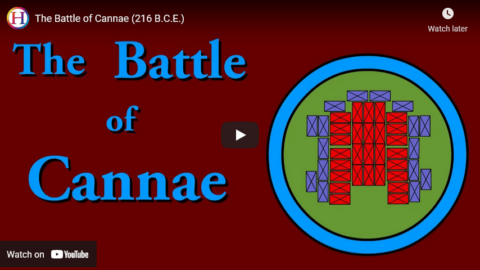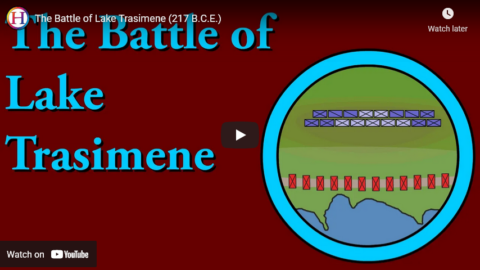The interest in war elephants, at least in the ancient Mediterranean, is caught in a bit of a conundrum. On the one hand, war elephants are undeniably cool, and so feature heavily in pop-culture (especially video games). In Total War games, elephants are shatteringly powerful units that demand specialized responses. In Paradox’s recent Imperator, elephant units are extremely powerful army components. Film gets in on the act too: Alexander (2004) presents Alexander’s final battle at Hydaspes (326) as a debacle, nearing defeat, at the hands of Porus’ elephants (the historical battle was a far more clear-cut victory, according to the sources). So elephants are awesome.
On the other hand, the Romans spend about 200 years (from c. 264 to 46 B.C.) mopping the floor with armies supported by war elephants – Carthaginian, Seleucid, even Roman ones during the civil wars (Thapsus, 46 B.C.). And before someone asks about Hannibal, remember that while the army Hannibal won with in Italy had almost no war elephants (nearly all of them having been lost in the Alps), the army he lost with at Zama had 80 of them. Romans looking back from the later Imperial period seemed to classify war elephants with scythed chariots and other failed Hellenistic “gimmick” weapons (e.g. Q. Curtius Rufus 9.2.19). Arrian (a Roman general writing in the second century A.D.) dismisses the entire branch as obsolete (Arr. Tact. 19.6) and leaves it out of his tactical manual entirely on those grounds.
This negative opinion in turn seeps into the scholarship on the matter. This is in no small part because the study of Indian history (where war elephants remained common) is so under-served in western academia compared to the study of the Greek and Roman world (where the Romans functionally ended the use of war elephants on the conclusion that they were useless). Trautmann, (2015) notes the almost pathetic under-engagement of classical scholars with this fighting system. Scullard’s The elephant in the Greek and Roman World (1974) remains the standard text in English on the topic some 45 years later, despite fairly huge changes in the study of the Achaemenids, Seleucids, and Carthaginians in that period.
All of which actually makes finding good information on war elephants quite difficult – the cheap sensational stuff often fills in the gaps left by a lack of scholarship. The handful of books on the topic vary significantly in terms of seriousness and reliability.
Bret Devereaux, “Collections: War Elephants, Part I: Battle Pachyderms”, A Collection of Unmitigated Pedantry, 2019-07-26.
April 29, 2023
QotD: The problem of war-elephants
February 16, 2022
Roman Republic to Empire 02 The Carthaginian Curse
seangabb
Published 5 Feb 2021[Update 2023-03-02 – Dr. Gabb took down the original posts and re-uploaded them.]
Here is the second lecture, which describes the vindictive treatment of Hannibal and Carthage, and explains this in terms of how the Second Punic War destabilised both Italy and the Roman Constutition. Between January and March 2021, Sean Gabb explored this transformation with his students. Here is one of his lectures. All student contributions have been removed.
(more…)
December 13, 2021
The Battle of Cannae (216 B.C.E.)
Historia Civilis
Published 29 Jun 2015Patreon | http://historiacivilis.com/patreon
Donate | http://historiacivilis.com/donate
Merch | http://historiacivilis.com/merch
Twitter | http://historiacivilis.com/twitter
Website | http://historiacivilis.comMusic is Beethoven’s “Sonata No. 32 in C Minor, Op. 111” – I. Maestoso – Allegro con brio ed appassionato, performed by Daniel Veesey
December 6, 2021
The Battle of Lake Trasimene (217 B.C.E.)
Historia Civilis
Published 22 Jun 2015Patreon | http://historiacivilis.com/patreon
Donate | http://historiacivilis.com/donate
Merch | http://historiacivilis.com/merch
Twitter | http://historiacivilis.com/twitter
Website | http://historiacivilis.comMusic is Beethoven’s “Sonata No. 07 in D Major, Op. 10 No. 3” – I. Presto, performed by Daniel Veesey.
December 3, 2021
The Battle of the Trebia River (218 B.C.E.)
Historia Civilis
Published 12 Jun 2015Patreon | http://historiacivilis.com/patreon
Donate | http://historiacivilis.com/donate
Merch | http://historiacivilis.com/merch
Twitter | http://historiacivilis.com/twitter
Website | http://historiacivilis.comMusic is Beethoven’s “Sonata No. 11 in B Flat Major Op. 22” – I. Allegro con brio. Performed by Daniel Veesey
March 17, 2018
The Battle of Cannae (Second Punic War) (Lecture)
The Study of Antiquity and the Middle Ages
Published on 16 Mar 2018This lecture aimed towards High School students features the battle of Cannae.
The Battle of Cannae (/ˈkæniˌ-neɪˌ-naɪ/[) was a major battle of the Second Punic War that took place on 2 August 216 BC in Apulia, in southeast Italy. The army of Carthage, under Hannibal, surrounded and decisively defeated a larger army of the Roman Republic under the consuls Lucius Aemilius Paullus and Gaius Terentius Varro. It is regarded both as one of the greatest tactical feats in military history and as one of the worst defeats in Roman history.
Having recovered from their losses at Trebia (218 BC) and Lake Trasimene (217 BC), the Romans decided to engage Hannibal at Cannae, with roughly 86,000 Roman and allied troops. They massed their heavy infantry in a deeper formation than usual, while Hannibal used the double-envelopment tactic. This was so successful that the Roman army was effectively destroyed as a fighting force. Following the defeat, Capua and several other Italian city-states defected from the Roman Republic to Carthage.
December 15, 2015
Hannibal Barca’s tactical triumph and strategic failure
William Brooke Stallsmith explains how Hannibal’s amazing string of battlefield successes still ended up meaning little in the larger war between Rome and Carthage:
Hannibal Barca of Carthage was one of history’s most remarkable commanders. In 218 BCE, at the start of the Second Punic War, he led an army of Carthaginian regulars, barbarian allies, and mercenaries — not to mention a few elephants — over the Alps into Italy and over the next few years nearly brought Rome to its knees. Hannibal scored a series of victories, which climaxed at the Battle of Cannae in August 216 BCE, where his 50,000 soldiers enveloped and destroyed nearly twice as many Roman legionnaires, including both consuls of the Roman Republic.
After Cannae, Hannibal controlled nearly all of Italy. Roman military forces on the peninsula were in tatters, and the republic was on the verge of panic. But this great triumph — still studied today as the model for a battle of complete annihilation of the enemy — turned out to be a strategic dead-end. Its aftermath was 15 more years of war and a harsh Roman-dictated settlement that ended centuries of Carthaginian power in the Western Mediterranean.
I think the reasons for Hannibal’s ultimate defeat lay not so much in any failings on his part as in the resilience and flexibility of the Roman Republic. Resilience was built into the nature of the state and the character of its citizens. This fundamental trait made it possible for Rome’s Senate and other institutions to shake off their initial panic and adapt to the new situation created by Cannae. They mobilized the Republic’s manpower and other resources with a ruthless efficiency would have made Albert Speer blink. While new legions were being formed and trained, Roman command in Italy went to a septuagenarian ex-consul, Quintus Fabius Maximus. He refused to engage his limited forces in pitched battle against Hannibal and focused instead on pinprick harassment and the disruption of Carthaginian supply lines.
When the Romans had regained strength and confidence, new adaptations were made. Roman institutions harnessed the energy and lust for glory of an aggressive young commander, Publius Cornelius Scipio Africanus. Scipio led an offensive into the Carthaginian heartland in North Africa and inflicted the final defeats on Hannibal’s army that ended the war on Roman terms.
November 25, 2015
The delaying tactics of Fabius Cunctatus
James Holmes suggests a few lessons modern tacticians can learn from the great Roman general, Quintus Fabius Maximus:
Quintus Fabius would nod knowingly at seeing the world turned upside down. Celebrated as Fabius Cunctatus (“the Delayer”), the Roman dictator lent his name to strategies whereby commanders deploy strategically defensive yet tactically offensive methods to forestall a decisive battle — all while marshaling manpower, implements of war, and other resources to right the military imbalance.
Skillfully prosecuted, a Fabian strategy proffers an opportunity to defeat a superior foe in a conventional trial of arms. And indeed, Fabius’s feats of arms earned him the nickname “Maximus” among Romans — signifying rock-star status. Historians of classical antiquity ranging from Polybius to Plutarch to Machiavelli considered him an icon of patient, guileful martial statecraft.
Polybius retells Fabius’s tale expertly. After trekking over the Alps, the Carthaginian warlord Hannibal’s army had rampaged throughout Italy, compiling a virtually unbroken record of battlefield victory. In particular, his triumph over the Roman legions at Cannae won enduring fame in Western military circles. Two millennia later General Dwight Eisenhower recalled in his memoir Crusade in Europe, “Every ground commander seeks the battle of annihilation,” maintained Eisenhower; “he tries to duplicate in modern war the classic example of Cannae.”
Granted emergency powers, Fabius assumed personal command of the legions and encamped near the Carthaginian host at Aecae. Upon learning that the Roman army was nearby, Hannibal resolved to “terrify the enemy by promptly attacking.” The Roman riposte? Nothing. No one responded to the Carthaginians’ approach. They trudged back to camp. Having acknowledged his army’s “manifest inferiority,” Fabius “made up his mind to incur no danger and not to risk a battle.”
He was ornery that way. Better to live to fight another day, and on more favorable terms. Why rush in and risk fresh disaster? Rome was fighting on home turf. Its armies were beneficiaries of an “inexhaustible supply of provisions and of men.” Fabius only needed time to tap that potential, transforming latent into kinetic military power.






